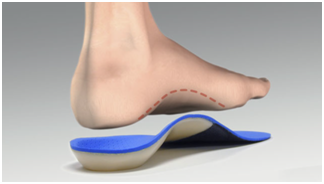Blog
Using Honey on Cracked Heels
 Honey, while typically used as a cooking ingredient, is very useful in remedying dry and cracked heels. The mixture includes warming a cup of honey and stirring in two tablespoons of milk. Once those two ingredients are mixed, cut half of an orange and squeeze the juice into the mixture and it becomes a paste.
Honey, while typically used as a cooking ingredient, is very useful in remedying dry and cracked heels. The mixture includes warming a cup of honey and stirring in two tablespoons of milk. Once those two ingredients are mixed, cut half of an orange and squeeze the juice into the mixture and it becomes a paste.
Before applying the paste of the heels, wash feet and try to clean off dead skin with a pumice stone. Apply the paste to the heels and let it sit overnight. Regular use of the honey paste should heal the skin in under a month.
Cracked heels can become painful if left untreated. To learn more, consult with Dr. Michael E. Newman of Pennsylvania. Our doctor will attend to all of your foot and ankle needs.
The Truth about Cracked Heels
Cracked Heels
Cracked heels are unappealing, and make it harder for you walk around in sandals. Not only may they look bad, but they can also tear stockings, socks, and wear out your shoes. There are several methods to help restore a cracked heel and prevent further damage.
How do you get them?
Dry skin is the number one culprit in creating cracked heels. Many athletes, walkers, joggers, and even swimmers suffer from cracked heels. Age and skin oil production play a role to getting cracked heels as well.
Promote Healing
Over the counter medicines can help, especially for those that need instant relief, or who suffer from chronic dry feet.
Wear Socks – wearing socks with medicated creams, helps lock in moisture so it can stay on longer.
Moisturizers – applying it both day and night will help alleviate dryness which causes cracking.
Pumice Stones – these remove dead skin, and then you can massage cream onto your foot. This way the cream will be absorbed. The skin needs to be exfoliated; therefore the outer layer dead skin needs removal.
If you have any questions, please feel free to contact our offices located in Plymouth Meeting and Ambler, PA. We offer the latest in diagnostic and treatment technologies to meet all your needs.
Read more about Cracked Heels
Hawks Forward Sidelined With Broken Toe
 Earlier this month, Atlanta Hawks forward Michael Scott fractured his left big toe and will have to sit out for the next couple of games. Scott’s injury was caused during their loss against the Nuggets and was originally only thought to be a sprain.
Earlier this month, Atlanta Hawks forward Michael Scott fractured his left big toe and will have to sit out for the next couple of games. Scott’s injury was caused during their loss against the Nuggets and was originally only thought to be a sprain.
As soon as the forward returns to Atlanta to see the team’s doctors, the Hawk’s will find out when their key player will return. It is possible that Scott could be out until the play offs.
A broken toe is a very serious condition that should be treated as soon as possible. If you are experiencing problems with a broken toe contact Dr. Michael E. Newman and Dr. Denise Kohler of Pennsylvania. Our doctors will treat your foot and ankle needs.
What to Know About a Broken Toe
Although most people try to avoid foot trauma such as banging, stubbing, or dropping heavy objects on their feet, the unfortunate fact is that it is a common occurrence. Given the fact that toes are positioned in front of the feet, they typically sustain the brunt of such trauma. When trauma occurs to a toe, the result can be a painful break (fracture).
Symptoms of a Broken Toe
- throbbing pain
- swelling
- bruising on the skin and toenail
- the inability to move the toe
- toe appears crooked or disfigured
- tingling or numbness in the toe
Generally, it is best to stay off of the injured toe with the affected foot elevated.
Severe toe fractures may be treated with a splint, cast, and in some cases, minor surgery. Due to its position and the pressure it endures with daily activity, future complications can occur if the big toe is not properly treated.
If you have any questions please feel free to contact our offices located in Plymouth Meeting and Ambler, PA. We offer the newest diagnostic and treatment technologies for all your foot and ankle needs.
Proper Supportive Footwear can Prevent Long Term Foot Problems
 Whether you were born with perfect feet or have every ailment possible in your lower extremities, it is necessary to have the proper footwear to avoid future pain and practice every day foot care. Often time many common foot problems such as plantar fasciitis, heel spurs, and hammertoes occur because of ill-fitting and unsupportive footwear. By having your foot fitting for the best type of shoe that suits your needs, you are treating and preventing foot complications.
Whether you were born with perfect feet or have every ailment possible in your lower extremities, it is necessary to have the proper footwear to avoid future pain and practice every day foot care. Often time many common foot problems such as plantar fasciitis, heel spurs, and hammertoes occur because of ill-fitting and unsupportive footwear. By having your foot fitting for the best type of shoe that suits your needs, you are treating and preventing foot complications.
Finding shoes with the proper fit and support is only one portion in maintaining everyday foot care. For more information about everyday foot care, consult with one of our podiatrists of Michigan Foot and Ankle. Our doctors will provide you with the foot- and ankle information you seek.
Every Day Foot Care
Often, people take care of their bodies, face and hair more so than they do for their feet. But the feet are a very important aspect of our bodies, and one that we should pay more attention to. After all, without our feet, we would not be able to perform most daily tasks. It is best to check your feet regularly to make sure there are no new bruises or cuts that you may not have noticed before, for example.
For dry feet, moisturizer can easily be a remedy and can be applied as often as necessary to the affected areas. Wearing shoes that fit well can also help you maintain good foot health, as well as making it easier to walk and do daily activities without the stress or pain of ill-fitting shoes, high heels, or even flip flops.
Also, wearing clean socks with closed shoes is important to ensure that sweat and bacteria do not accumulate within the shoe. Clean socks help to prevent athlete’s foot, fungi problems, bad odors, and can absorb sweat.
If you have any questions, please feel free to contact our offices, located in Ferndale, Milford, and Commerce Township, MI. We offer the newest diagnostic and treatment technologies for all of your foot ankle injuries.
Read more about Everyday Foot Care
Women more likely to develop Stress Fractures
 Studies have shown that women are at a greater risk of developing stress fractures than men. Reasons for this increased risk include hormonal differences, increased bone density, and higher rates of inadequate nutrition. While athletes in general are at highest risk after changes in intensity, frequency or duration of their workouts; in women, irregular menstrual cycles and weight less than 75 percent of ideal body weight are factors that make for an increased risk for stress fractures. Stress fractures are small cracks that develop in the bone after being stressed, and are most common in the foot, ankle, and lower leg but can occur on bones throughout the body.
Studies have shown that women are at a greater risk of developing stress fractures than men. Reasons for this increased risk include hormonal differences, increased bone density, and higher rates of inadequate nutrition. While athletes in general are at highest risk after changes in intensity, frequency or duration of their workouts; in women, irregular menstrual cycles and weight less than 75 percent of ideal body weight are factors that make for an increased risk for stress fractures. Stress fractures are small cracks that develop in the bone after being stressed, and are most common in the foot, ankle, and lower leg but can occur on bones throughout the body.
Stress fractures can become painful if left untreated for an extended period of time. If you would like assistance in treating a stress fracture in the foot or ankle, consult with Dr. Michael E. Newman of Pennsylvania. Our doctor can determine the severity of your condition and provide you with quality care.
Coping with Podiatric Stress Fractures
Stress Fractures occur on the foot and ankle when muscles in these areas weaken as a result of overexertion or underuse. As a result, the ankles and feet lose support when walking or running from the ground. Since these bones are not protected, they receive the full impact of each step. The stress on the feet causes the bones to form cracks.
What are Stress Fractures?
Stress Fractures are very common among those who are highly active and involved in sports or activities that make excessive use of their legs and feet. Stress fractures are especially common among:
-athletes (gymnasts, tennis players, basketball players)
-runners/joggers
-osteoporosis patients
-those who engage in high-intensity workouts
Stress Fracture Symptoms
Pain from the fractures occur in the area of the fractures, and can be either constant or periodic. The pain is usually sharp or dull, accompanied by swelling and tenderness. Engagement in any kind of high impact activity will exacerbate the pain.
For more information about Stress Fractures of the Foot and Ankle, follow the link below.
If you have any questions, please feel free to contact our offices located in Plymouth Meeting and Ambler, PA. We offer the newest diagnostic and treatment technologies for all your foot and ankle needs.
